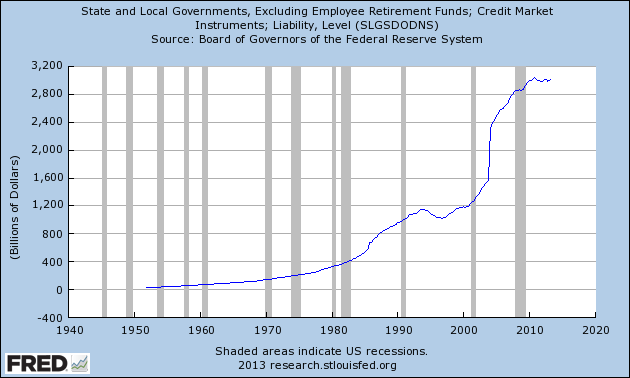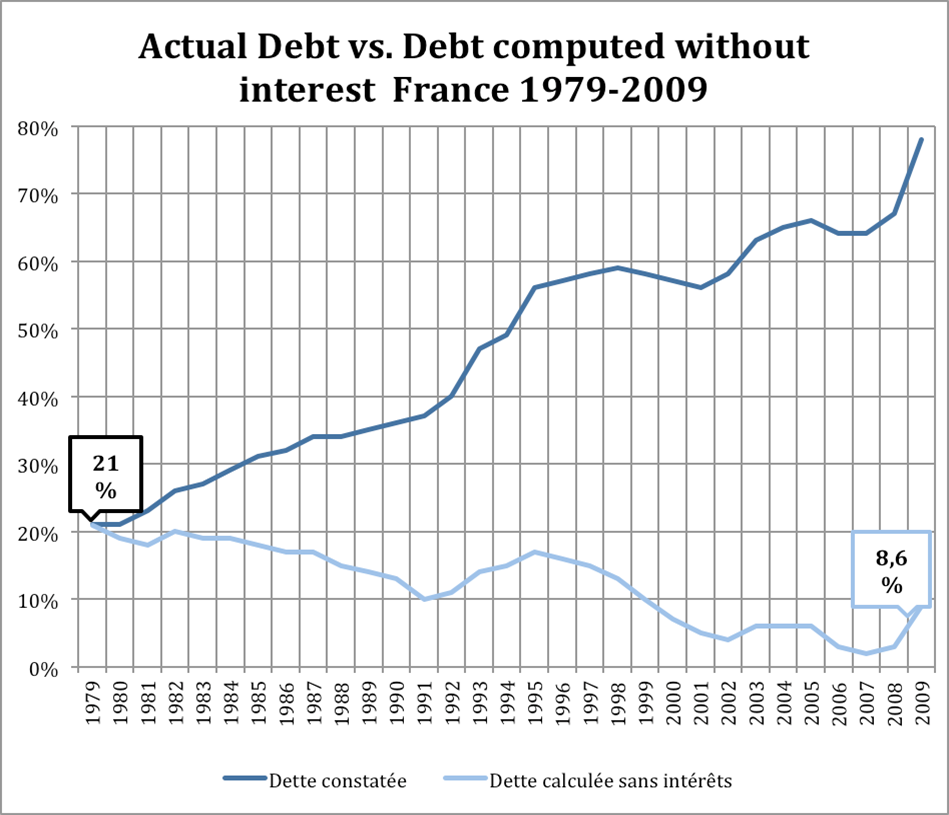From the Editor:
As 2013 draws to a close, state,
local, and federal governments are battling debt and
interest burdens that are greater than ever. Their receipts
are down and their bills are up. The only alternative has
been to borrow – at interest – creating an exponentially
growing debt. While "conservatives" express alarm at the
ever-increasing debt levels and "liberals" denounce calls
for austerity and cuts in essential services, there is one
concern that should be shared by the 99%: Borrowing at
interest increases costs and debt and transfers wealth out
of our communities and into the pockets of Wall Street
financiers, unless we borrow from our own
publicly-owned banks.
From 2000 to 2010, the
total debt of state
and local governments increased by a factor of 2.5 from $1.2
trillion to approximately $3 trillion. With burdening
compound interest, this increased debt has put a strain on
the
budgets of states
and local communities, which are required to balance their
budgets, forcing states and communities to not only cut
spending, but, in some cases, take on further debt. Some
states, including
California and
New York, have
worked to curb their debt spending as their debt burdens had
become increasingly unmanageable.

In 2011, according to the
US Census Report,
revenues for all state and local governments totaled $3.2
trillion, taxes totaled $1.3 trillion, and interest payments
on debt totaled $124 billion, or
9.2% of tax receipts and 3.9% of the total
revenues. This is bad enough but it is slated to get worse;
and the federal situation is already worse.
According
to the federal fiscal year
2013 budget report,
the total federal budget was $3.5 trillion, personal income
tax receipts were $1.3 trillion, and the interest on the
debt was $416 billion, or
31.6% of tax receipts. “Net interest” is often
quoted, since some of the debt is held by Social Security
and other government trust funds. For fiscal year 2013, the
net interest payments on the debt totaled $223 billion, or
16.9% of personal income tax receipts, or 6.4%
of the total budget.
Debt is an essential tool for
financing public infrastructure, spreading the costs over
several decades of use.
The problem is interest. Interest,
which is almost always
compounded, results
in exponentially increasing interest and debt, as well as
exponentially increasing bank assets and financial profits.
Even in times of economic stability, typical levels of debt,
at interest, increase costs unnecessarily and transfer huge
wealth over time out of our local states and communities,
enriching and empowering the Wall Street financiers.
In the article,
It's the Interest, Stupid! Why
Bankers Rule the World, Ellen Brown explains how
we can eliminate the burden of interest by recapturing it
with our own publicly-owned banks, at the state/local and
federal levels.
Borrowing from its own central bank interest-free might even
allow a government to eliminate its national debt
altogether. In
Money and Sustainability: The
Missing Link (at page 126), Bernard Lietaer and
Christian Asperger, et al., cite the example of France.
The Treasury borrowed interest-free from the nationalized
Banque de France from 1946 to 1973. The law then
changed to forbid this practice, requiring the Treasury to
borrow instead from the private sector. The authors
include a chart showing what would have happened if the
French government had continued to borrow interest-free
versus what did happen. Rather than dropping from 21%
to 8.6% of GDP, the debt shot up from 21% to 78% of GDP.
“No
‘spendthrift government’ can be blamed in this case,” write
the authors. “Compound interest explains it all!”

In fact, one state, North Dakota, has done just that. It
has stemmed the transfer of wealth via interest from the
state -- by owning its own bank. Under state law, the bank
is the State of North Dakota
doing business as the
Bank of North Dakota.
The Bank of North Dakota holds the state's deposits and
provides financing for the state and local economy, cutting
out out-of-state financiers. The North Dakota 2013-2015
approved
state budget has
no interest listed as an outlay, but
includes interest income instead.
Publicly-owned banks, as shown by the example of the
state-owned Bank of North Dakota, can eliminate
debt-servicing costs given to out-of-state financiers, and
use those savings to finance public projects themselves.
Further, publicly-owned banks can provide a source of
revenue for state and local communities, keeping state and
municipal deposits local, feeding the local economy rather
than feeding off of it.
Public banking advocates in
Vermont, so far
unsuccessful in their quest to get the Vermont Legislature
to study the feasibility of setting up a state-owned bank,
have taken the task upon themselves and released their own
preliminary
study. It is
expected that public banking advocates in other states and
communities will follow the example of those in Vermont and
others and perform their own studies.
Protectors of
the status quo argue that business as usual is acceptable
and prudent. However, we know that compound interest
increases costs and transfers wealth out of our communities,
creating power centers in Wall Street that make a charade of
our democracy. As
Glen Edens, former
HP executive, states: “...a strong financial services
industry is simply not good for society. Wall Street does
not improve productivity, the model is parasitic,
transferring huge resources out of the system...”
As
we approach the 100th year anniversary of the
Federal Reserve, established by the
Federal Reserve Act of 1913,
there are increasing calls to “federalize”
the private Federal Reserve -- to create a publicly-owned
central bank that operates in the public interest. As
Canada did from 1939
to 1974, and
France from 1946 to
1973, the US government could borrow essentially
interest-free from its own “federalized” Fed, resulting in a
sustainable economy and a manageably low (or no) federal
debt. Even a Harvard professor at the very recent 2013 IMF
conference has broached the idea of
opening the Fed to
accounts for the general public, leading others to take off
with the idea of the Fed as a real
people's bank.
Assessing the unnecessary interest burden that Main
Street endures, the evidence is clear: We the People need
public banking for a sustainable and shared prosperity.
Ann Tulintseff
Member of the Board, Public Banking
Institute |
|
No comments:
Post a Comment